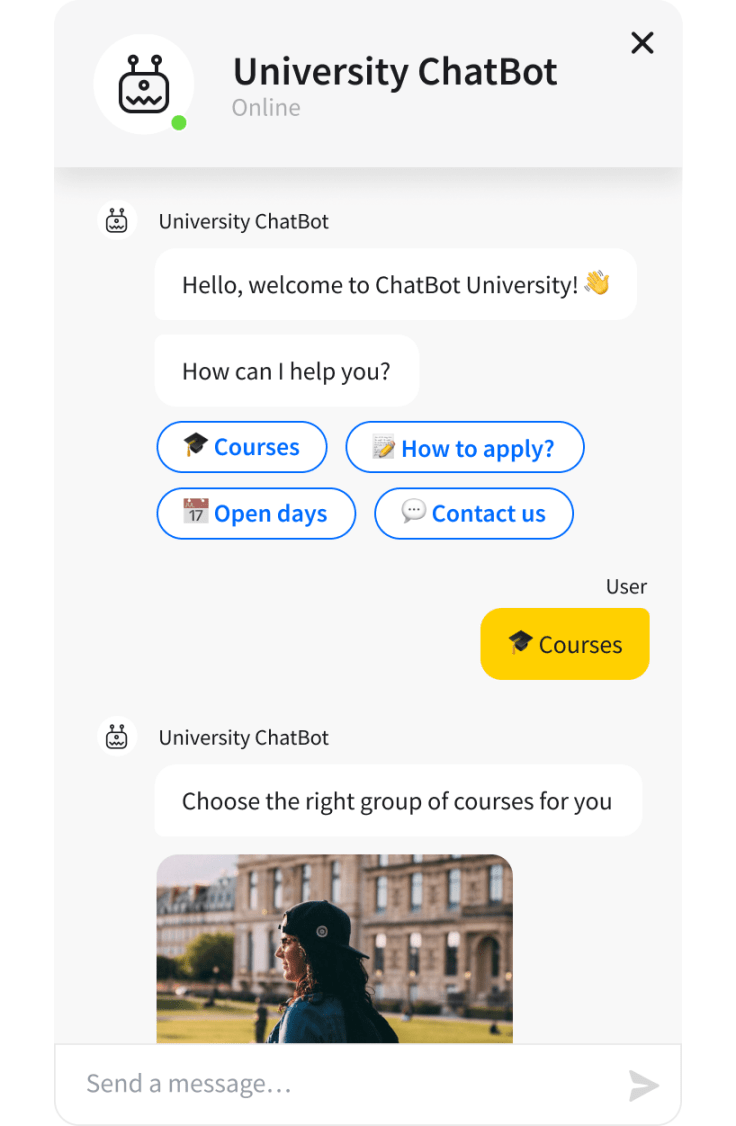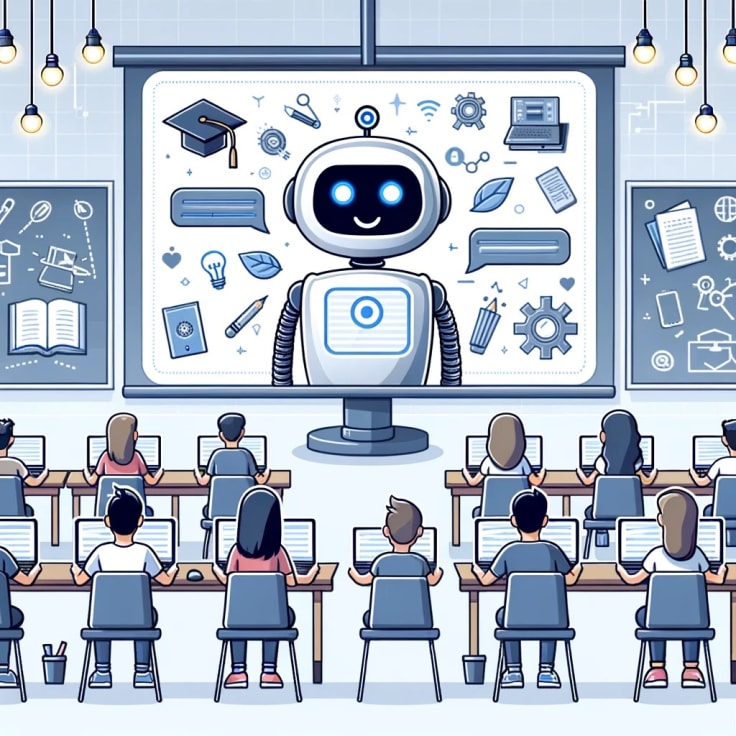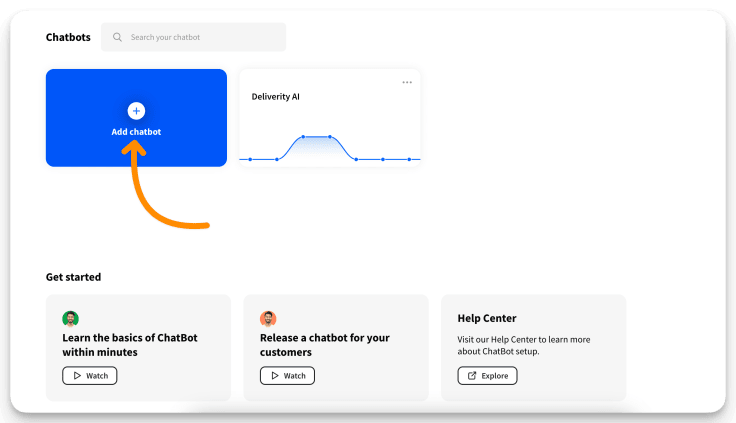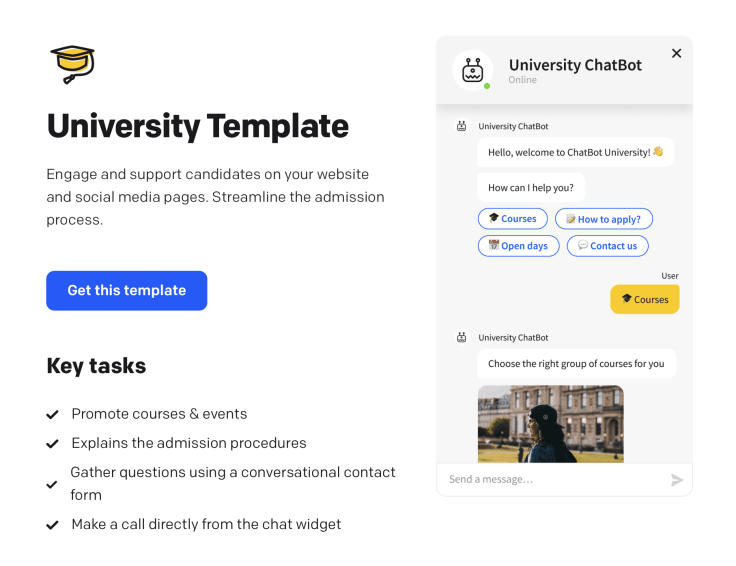Showing top 0 results 0 results found
Showing top 0 results 0 results found

How is technology shaping the future of education? With the rise of artificial intelligence (AI), chatbots are becoming a crucial part of educational frameworks globally.
In fact, education ranks among the top five industries utilizing chatbots, with 58% of educational institutions acknowledging that chatbots significantly improve their service offerings.
Chatbot technology is changing how institutions in the education industry interact with students, streamline processes, and deliver personalized learning experiences. These AI-powered assistants are vital in fostering a more engaging and effective educational environment.
In this article, I will explore various aspects of chatbots in education, including:
- What is an educational chatbot?
- Why should educational institutions use chatbots?
- The benefits of using chatbots in education.
- Practical use cases of chatbots within educational settings.
- The future of chatbots in education.
- Implementing the University Template by ChatBot.
Join me as I delve into how chatbots are revolutionizing learning and student support.
What is an educational chatbot?

Education chatbots facilitate various processes by serving as virtual teaching assistants, evaluating papers, retrieving alumni data, updating curriculums, and streamlining admissions. These tools, powered AI, are transforming how educational institutions, from EdTech startups to universities, engage with students and staff.
Companies like Duolingo and Mondly have leveraged these tools to significantly boost learner engagement and accelerate the comprehension of new concepts.
At their core, educational chatbots aim to streamline communication within the education sector, making learning experiences more interactive and responsive. Through real-time dialogue, chatbots answer queries to guide users through complex educational materials and administrative processes.
For example, a student might interact with a chatbot to get updates about course changes, submit assignments, or even receive personalized tutoring based on their learning pace and style. This way educational chatbots are becoming indispensable tools in modern education.
Why should educational institutions use chatbots?

In recent years, chatbots have become a crucial component in the digital strategy of educational institutions.
The push towards digital transformation was significantly accelerated by the 2020 pandemic, which underscored the need for schools, universities, and other educational centers to quickly adapt to new and evolving communication demands. Today, chatbots in education are essential elements for contemporary digital engagement.
Here are several compelling reasons why educational institutions should consider implementing chatbots:
- Immediate communication: Chatbots, powered by natural language processing (NLP), provide instant responses to student inquiries, crucial for maintaining engagement and satisfaction in our fast-paced world.
- Adaptability: They can be programmed to handle a vast array of tasks, from answering FAQs about course details and admissions to assisting in the enrollment process.
- Accessibility: With chatbots, students can access information and support anytime and anywhere, overcoming traditional barriers to communication.
The presence of conversational AI in educational settings enhances the student experience by offering a seamless, interactive, and responsive communication channel. As a tool that supports both current and prospective students, chatbots help educational institutions meet student's expectations for fast, efficient support.
Benefits of using chatbots in education

Education bots are influencing how institutions engage with students by enhancing learning and administrative processes.
Let’s look at how these AI-driven tools can be pivotal in education.
1. 24/7 learning support
Imagine a student preparing for an exam late at night and needing clarification on a complex topic. Normally, they'd have to wait until the next day for help, risking a break in study momentum and added stress. With educational chatbots, this is no longer a concern. These education chatbots provide answers at any hour, supporting students continuously and making learning stress-free.
The constant availability of chatbots means students can learn at their own pace and on their own schedule, which is crucial in today's diverse educational landscapes. Whether it’s during a midnight study session or early in the morning before class, chatbots are there to assist. For institutions, this translates to higher satisfaction and potentially better academic performance, as students feel supported whenever they need it.
Around-the-clock support extends beyond academic questions. Education chatbots help students navigate course materials, access library resources, and even connect them with human tutors if their queries are too complex.
2. Personalized educational experiences
Personalization in the online education system is not just a luxury; it's a necessity for effective learning. Education chatbots excel in this area by using machine learning to analyze data from student interactions to tailor educational content and responses. If a student frequently struggles with a particular concept, the chatbot can offer revised explanations, additional resources, or slower-paced guidance.
This kind of customization makes learning more engaging and digestible. Instead of a one-size-fits-all approach, each student receives a learning experience that adjusts to their needs and pace. For example, a visual learner might receive more infographic-based content, while a verbal learner might get more detailed text explanations.
Personalized interactions are not static. The chatbot can adapt as a student's understanding evolves, offering more complex material and challenges. Dynamic learning paths ensure continuous engagement and improvement, mirroring the benefits of a personal tutor without the associated high costs.
3. Streamlining administrative tasks
From handling enrollment queries to scheduling classes, educational chatbots can automate many administrative tasks, allowing staff to focus on more critical tasks that require human intervention.
For instance, during enrollment periods, chatbots can manage thousands of inquiries about deadlines, requirements, and procedures, reducing the workload on human staff and speeding up response times. Process automation significantly enhances operational efficiency, improving the overall student experience by providing quicker and more accurate information.
Chatbots are also equipped to handle personal data securely, ensuring that students' information is processed in compliance with privacy regulations. This is crucial in building trust and reliability in digital interactions within educational settings.
4. Enhancing engagement through interactive learning
Chatbots in education create interactive learning sessions that can engage students more deeply. Through simulations, quizzes, and problem-solving exercises, chatbots make learning active rather than passive.
A chatbot can turn a history lesson into an interactive story in which students make decisions that influence the outcome. Active studying makes learning more engaging and helps students understand the material's real-world application.
The conversational nature of chatbots can also mimic classroom discussions, allowing students to explore different viewpoints and think critically about the material. After all, more engaged students are more likely to better understand and retain information.
5. Multilingual accessibility
Multilingual chatbots democratize education by providing services in multiple languages, ensuring no student is left behind because of language barriers. This feature is particularly beneficial in diverse educational environments where students come from various linguistic backgrounds.
A multilingual chatbot can cater to an international student body, making educational content accessible to everyone. This helps in learning and administrative tasks, where understanding precise information is crucial. If a non-native English speaker can receive assistance in their native language, they can make complex processes like registration or financial aid applications much clearer and more manageable.
6. Data-driven insights
By continuously collecting student feedback on interactions with learning materials and responses to different teaching styles, education chatbots offer invaluable insights into the effectiveness of educational strategies. Student data can improve curriculum design, teaching methods, and student support services.
These insights are not just quantitative but qualitative as well, offering a deeper understanding of student engagement, pain points, and overall satisfaction. Armed with this information, educational institutions can tailor their offerings to better meet their students' needs.
7. Cost efficiency
Implementing chatbots in educational systems leads to substantial cost savings. Educational institutions can use them to automate mundane tasks, reduce administrative staff, decrease operational expenses, and allocate more resources to improving educational facilities and learning tools.
These savings also affect classroom operations, where chatbots can enhance traditional teaching methods by providing additional support that typically requires more staff. For instance, chatbots can provide extra tutoring or homework assistance, minimizing the necessity for comprehensive after-school programs.
8. Scalability
AI chatbots offer unparalleled scalability in higher education. They manage thousands of student interactions simultaneously without any drop in performance. During peak times, such as the beginning of the school year or during exams, their capability to provide information at scale outperforms any human.
Chatbots’ scalability ensures that every student receives timely and personalized responses, crucial for maintaining educational continuity and satisfaction. As institutions grow and student numbers increase, chatbots can easily scale to meet this growing demand without the need for proportional increases in human resources.
9. Feedback collection and analysis
Feedback is critical in any educational system, and chatbots simplify collecting and analyzing this valuable data. Chatbots integrate feedback mechanisms into routine interactions to gather real-time insights from students and educators, providing a constant stream of data on the effectiveness of teaching methods and materials.
Ongoing feedback allows institutions to make agile adjustments to their educational offerings, enhancing the quality of education.
10. Improving student retention
Chatbots contribute to higher student retention rates by providing consistent support and personalized learning experiences. Students who feel understood and supported are more likely to stay engaged with their courses and continue their education.
These tools can identify at-risk students through their interaction patterns to initiate proactive interventions, offering additional resources and support to help them succeed. This proactive approach improves individual student outcomes and enhances overall educational achievement.
11. Fostering inclusivity
Finally, chatbots play a crucial role in fostering inclusivity within education. They provide tailored support and adapt communication for students with different learning needs, ensuring that education is accessible to everyone, including those with disabilities.
This inclusivity extends beyond learning styles or disabilities. It encompasses various backgrounds and experiences, ensuring that all students feel valued and supported in their educational journey. Through this comprehensive support, chatbots help create a more inclusive and supportive educational environment, benefiting students, educators, and educational institutions alike.
Educational institutions can leverage platforms like ChatBot to enhance their services without needing extensive technical skills, thus driving forward a more effective, engaging, and inclusive educational experience.
Read this: 10 of the Best Chatbot Examples for You to Choose From
Chatbots in education: use cases

AI-driven chatbots are changing the teaching and learning experience.
Here are some notable chatbot use cases in education.
Streamlining admission processes
One of the critical areas where chatbots prove invaluable is in streamlining the admission processes. Handling hundreds of applications with diverse requirements can be daunting and prone to errors when done manually. Chatbots, however, can automate much of this process, from gathering initial student data to answering common questions about courses, fees, and application deadlines.
For example, a prospective student could interact with a chatbot to find out the necessary qualifications for a particular program, submit required documents, and even track the status of their application. This automation reduces the administrative burden and improves the accuracy and efficiency of the admissions process, allowing staff to focus on more complex inquiries and personalized student interactions.
Conducting student sentiment analysis
Understanding how students feel about their classes and overall educational experience is crucial for continuous improvement. Chatbots equipped with sentiment analysis can monitor and evaluate student feedback in real time, providing educators with immediate insights into the effectiveness of their teaching methods.
A chatbot might analyze students' textual responses in a post-lecture feedback form to determine if the content was clear or if students are struggling with specific topics. Immediate feedback allows educators to adjust their teaching strategies promptly, ensuring that students understand the material and feel supported in their learning journey.
Serving as AI-powered teacher assistants
Teachers often find themselves bogged down by repetitive administrative tasks such as taking attendance, grading quizzes, or scheduling appointments, which can detract from their main focus—teaching. Chatbots can take over these mundane tasks, acting as AI-powered assistants that help manage the classroom and administrative duties.
AI support frees up teachers to concentrate on creating more engaging and interactive lessons, thus improving the overall quality of education. It also allows them more time to offer individualized attention to students who may need extra help or guidance, enhancing the learning experience.
Facilitating on-demand learning assistance
Chatbots can provide students with on-demand learning assistance outside of regular class hours. Whether a student needs help with homework late at night or wants to clarify a doubt over the weekend, chatbots are available 24/7 to assist.
If a student struggles with a math problem, they can ask a chatbot for step-by-step guidance. The tool could offer hints, solve similar problems, or even link to relevant learning resources.
Students can better understand and retain the material when offered such continuous support in learning.
Enhancing language learning
Language learning is another area where chatbots are particularly effective. They can simulate natural conversations, allowing students to practice new languages in a stress-free environment. Students can talk to chatbots to improve their language skills, including vocabulary, grammar, and pronunciation.
Conversation-based approach helps build confidence and fluency, providing learners with a more interactive and engaging way to practice languages compared to traditional study methods.
Managing library services
Educational institutions can also employ education chatbots to manage and streamline library services. They can assist students and faculty by checking book availability, reserving materials, and answering questions about library hours and policies.
Students could interact with a chatbot to reserve a study room, ask about the due date for a loaned book, or find out if a particular journal is available. The entire process doesn’t require direct human intervention. Enhancing the availability of educational resources makes the library more accessible and user-friendly.
Organizing and promoting campus events
Lastly, chatbots are excellent tools for organizing and promoting campus events. They can send reminders, provide event details, and answer FAQs about various campus activities, from guest lectures to sports events and student club meetings.
This proactive communication helps increase participation and awareness, ensuring that students have all the information they need to take full advantage of campus life. Chatbots can even facilitate event registration, making it easier for students to get involved in activities that interest them.
Future of chatbots in education
The potential of AI and chatbots to transform educational systems is immense. As technology advances, these tools are set to redefine the traditional educational models, making learning more personalized, accessible, and efficient.
Here’s a glimpse into how the future of chatbots might impact education:
- Personalized learning journeys: Using machine learning and natural language processing, education chatbots will enable the creation of tailored experiences that adapt to the individual learning styles and paces of students in an educational institution. An education system where lessons and resources are customized to meet the unique needs of each learner will replace the conventional one-size-fits-all approach.
- Instantaneous assistance: As virtual assistants, chatbots will provide immediate help, clarifying doubts and answering questions in real time. Students will overcome obstacles as soon as they encounter them, facilitating a smoother and more continuous learning process.
The impact of AI in education goes beyond just student interaction. Researchers are leveraging AI to develop systems to measure student engagement and comprehension during lessons. This capability allows for the collection of precise feedback on the effectiveness of teaching methods and materials, enabling continuous improvement in educational content and delivery.
Looking forward, the proliferation of AI technologies promises a future where quality education is more accessible than ever. Chatbots will not only assist in learning but also democratize education, making it easier for students from all backgrounds to access high-quality educational resources and support. As these technologies evolve, they will continue to break down barriers and enhance the learning experience for students around the globe.
Implement the University Template by ChatBot

At ChatBot, we’ve created a University Template designed specifically for educational institutions looking to enhance their engagement with prospective students. This template is a powerful tool for streamlining the admission process and improving the overall candidate experience on your website and social media platforms.
Here's what the University Template offers:
- Detailed program information: The chatbot provides potential applicants with comprehensive details about your institution’s programs and courses.
- Guidance on admission procedures: It clearly explains the steps involved in the admission process, including registration deadlines, helping to simplify what can often be a complex journey for applicants.
- Event promotion: The chatbot can promote university open days and other significant events, making it easy for candidates to stay informed and involved.
- Direct communication options: Candidates can directly call your department or leave a message through the chat window if they need more personalized information.
Implementing this template is really simple. You can start with a free 14-day trial to explore how the University Template can work for your institution. This trial period allows you to see firsthand how the chatbot can engage with applicants, field their questions, and provide them with the necessary information to make informed decisions about their educational future.
You can integrate this chatbot into your communication strategy, making the admission process more accessible. Ensure your institution stands out by providing every prospective student a responsive and personalized experience.
Conclusion
The transformative power of chatbots in education cannot be overstated. From streamlining administrative tasks and enhancing learning experiences with personalized content to offering multilingual support and providing round-the-clock assistance, chatbots are reshaping the educational landscape.
Chatbots equip institutions to meet the challenges of today's digital world and prepare for the future of education, which promises even greater integration of AI technologies.
Ready to revolutionize your educational institution's approach? Check out ChatBot’s University Template. It's designed specifically to enhance student engagement and simplify admissions, helping you provide a seamless experience for prospective students.
FAQ
What exactly is an educational chatbot?
An educational chatbot is an AI-driven virtual assistant designed to help educational institutions interact more effectively with students and staff. It supports a range of activities including student instruction, administration, admissions, and even personalized tutoring, helping to streamline operations and enhance the learning experience.
How do chatbots improve the learning experience for students?
Chatbots enhance the learning experience by providing 24/7 support, personalized learning paths, and interactive engagement. They adapt to individual learning styles and paces, offer instant feedback, and help maintain student interest and motivation by making learning more dynamic and accessible.
Can chatbots in education really help with administrative efficiency?
Yes, chatbots significantly improve administrative efficiency by automating routine tasks such as admissions processing, scheduling, and handling FAQs. This frees up administrative staff to focus on more complex tasks and improves the overall operational efficiency of educational institutions.
Are there privacy concerns with using chatbots in education?
While implementing chatbots involves handling sensitive information, most modern chatbots are designed with robust security measures to ensure data privacy and compliance with educational standards and regulations. Institutions should ensure that their chatbot solutions comply with laws like FERPA and GDPR.
How can educational institutions get started with implementing chatbots?
Educational institutions can start by identifying areas where chatbots could have the most impact, such as customer service, admissions, or student support. ChatBot offers the University Template that can be customized to meet specific needs.



